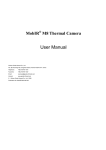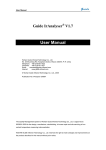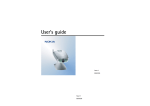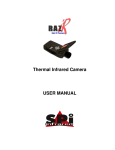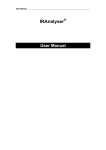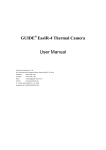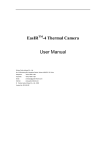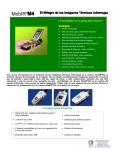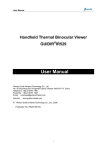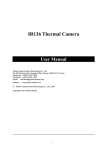Download User Manual - Australian Thermal Imaging
Transcript
User Manual MobIR® M4 Thermal Camera User Manual Wuhan Guide Infrared Technology Co., Ltd. No. 26 Shucheng Rd, Hongshan District, Wuhan 430070 P. R. China Telephone: +86-27-8767 1925 Facsimile: +86-27-8767 1927 Email: [email protected] Internet: www.guide-infared.com ® Wuhan Guide Infrared Technology Co., Ltd., 2005 ® Publication No: MobIR M4 UM 008 User Manual The Quality Management System of Wuhan Guide Infrared Technology Co., Ltd. is approved to ISO9001:2000 for the design and manufacture, stockholding, in-house repair and site servicing of non contact temperature measuring instrumentation. WUHAN GUIDE Infrared Technology Co., Ltd. reserves the right to make changes and improvements on any of the products described in this manual without prior notice. MobIR® M4 Thermal Camera complies with current European directives relating to electromagnetic compatibility and safety. (EMC directive 89/336/EEC; Low voltage directive 73/23/EEC) Copyright © Wuhan Guide Infrared Technology Co., Ltd, 2005. All rights reserved worldwide. No parts of the products may be reproduced, transmitted, transcribed or translated into any language or computer language in any form or by any means, electronic, magnetic, optical, manual or otherwise, without the prior written permission of Wuhan Guide Infrared Technology Co., Ltd. This manual must not, in whole or part, be copied, photocopied, reproduced, translated or transmitted to any electronic medium or machine readable form without prior consent, in writing, from Wuhan Guide Infrared Technology Co., Ltd. User Manual Table of Contents Table of Contents ...................................................................................................... 3 Introduction ............................................................................................................... 4 Precautions ............................................................................................................... 5 Maintenance ............................................................................................................. 6 Calibration and Repair Philosophy ............................................................................ 7 Technical Support...................................................................................................... 7 Feedback to Us ......................................................................................................... 7 System Overview ...................................................................................................... 8 Customer Benefits..................................................................................................... 9 System Configuration................................................................................................ 9 Technical Specifications .......................................................................................... 10 Chief Functions ....................................................................................................... 12 Parts Described....................................................................................................... 14 Quick Start Guide .................................................................................................... 16 Quick Reference Table ............................................................................................ 17 Introduction to Buttons ............................................................................................ 18 Button Relations...................................................................................................... 20 Using the Camera – In Detail .................................................................................. 21 Battery Charging ..................................................................................................... 47 Troubleshooting ...................................................................................................... 49 Emissivity ................................................................................................................ 51 Typical Emissivity Values ........................................................................................ 53 User Manual Introduction This publication provides the necessary information required to safely operate the MobIR® M4 Thermal Camera. Compared with previous ones, this edition has been revised according to camera modification, such as the extended temperature range up to 250℃, the alternative for switch between Celsius and Fahrenheit, the background modification function, etc It is important to fully check all equipment with which you have been supplied The equipment should be used, maintained and serviced by suitably trained personnel, capable of carefully following the procedures and guidelines given in this User Manual All User Manuals and leaflets should be read thoroughly before proceeding with operation of the equipment It is also advisable that all User Manuals and Instruction Leaflets supplied are kept readily available, for reference when the equipment is in general use User Manual Precautions The following precautions must be adhered to at all times and must be considered in addition to any advised precautions issued at the relevant worksite or work area • Do not direct the MobIR® M4 Thermal Camera at very high intensity radiation sources such as the sun, carbon dioxide lasers or arc welders etc • Always replace the lens cap when the unit is not in operation • Do never point the MobIR® M4 Thermal Camera at high-temperature object when switching on • Wait for 10 seconds or longer to restart the camera after turning it off • Keep the MobIR® M4 Thermal Camera steady when operating on it • The MobIR® M4 Thermal Camera shall work between -10℃ and +50℃ • When the MobIR® M4 Thermal Camera is not in use or is to be transported, ensure that the unit and accessories are stored in the protective carry case • The MobIR® M4 Thermal Camera incorporates precision optical equipment and static-sensitive electronics which should be protected from shock and vibration at all times • • Do not jam the air vent on the MobIR® M4 Thermal Camera body Do not attempt to open the camera body, as this action will void the warranty The MobIR® M4 Thermal Camera utilises a Lithium Ion (Li-Ion) rechargeable battery pack. The following safety precautions must be adhered to at all times to ensure the safe use of this equipment • • • • Do not disassemble or attempt to open the battery under any circumstances Do not expose the battery to fire or high temperatures Do not short circuit the battery Do keep the battery off moisture or water User Manual • Charging of the battery should only be carried out using the recommended or supplied charging device Maintenance To ensure that the MobIR® M4 Thermal Camera is kept in good working condition and remains fully operational, the following guidelines should be adhered to at all times Non-optical surfaces The non-optical surfaces of the camera can be cleaned when required, with a soft cloth dampened with water and a mild detergent Optical surfaces The optical surfaces of the camera lens should only be cleaned when visibly dirty. Care should be taken to avoid touching the exposed lens surface, as skin acid left behind from fingerprints can be damaging to coatings and lens substrates. Use only a proprietary lens cleaning tissue User Manual Calibration and Repair Philosophy To ensure the accuracy and reliability of the MobIR® M4 Thermal Camera, it is highly recommended that the instrument be calibrated at 12 monthly intervals Contact Wuhan Guide to arrange for the instrument to be returned to Wuhan Guide calibration centre for a calibration check, or in the unlikely event of a component or system failure, for repair Caution The MobIR M4 IR Thermal Camera does not incorporate any user serviceable parts. Never attempt to disassemble or modify the camera. Opening the unit invalidates the warranty ® Technical Support Technical support for your Wuhan Guide Thermal Imaging System can be obtained by either contacting the address / telephone number on the cover of this User Manual or by Email to the following address: [email protected] Feedback to Us We have tested and verified the information in this manual to the best of our abilities. Yet as we are committed to continuous development and progress, you might find features of the product have been changed since the time of printing. You are appreciated to let us know about any error you find, and your suggestions for further editions by either contacting the address/telephone number on the cover of this User Manual, or by Email to the following address: [email protected] User Manual System Overview Wuhan Guide MobIR M4 Thermal Camera leads another breakthrough in today’s Infrared Thermal Imaging industry. ® Emerging as the first mobile phone like IR camera in the world, the MobIR® M4 Thermal Camera is sized, configured and priced to open the door to many new uses of Thermal IR Imaging. It provides a wide assortment of unique new features enabling professional thermographers to work with efficiency and productivity greater than ever before: crisp thermal and visual imaging, efficient voice annotation, fully onboard image processing, large capacity in-field storage, fast image download via USB connectivity, low power dissipation and long durability, and more. MobIR® M4 Thermal Camera is the only IR camera that offers all the possibilities of a high range camera at an unanticipated affordable price, enabling high-performance thermal imaging where never possible before. User Manual Customer Benefits As an ultra-portable IR camera with big-camera power, the MobIR® M4 Thermal Camera provides outstanding thermal imaging of the highest quality and presents a range of benefits to the customers, which can be seen below: • • • • • • • • • Ultra-compact, lightweight & fully integrated Easy of carry and operation Precision non-contact temperature measurement Ultra large capacity in-field image storage Plug-and-play connectivity Low power dissipation and long durability Robust post- processing software Affordable price & high reliability License free & rapid delivery System Configuration Please ensure that the following items have been correctly supplied: • • • • • • • • • • • • MobIR® M4 Thermal Camera with visual camera 13mm IR lens Two rechargeable Li-ion batteries Battery charger USB extension cable Earphone USB driver Post-analysis software Guide IrAnalyser® User manual Leather sheathe Soft carry bag Packing case User Manual Technical Specifications Image Performance Thermal: Detector Type: Spectral Range: Field of View/ Focus: Thermal Sensitivity: Image Display Electronic Zoom: Visual: Built-in Digital Video: External Display: Temperature Range: Accuracy: Measurement Modes: Measurement Correction: Type: File Format: Microbolometer UFPA (160 x 120 pixels, 35μm) 8-14μm 25° x 19°/12.6mm ≤120mk @30℃ 256 level, 8 palettes (Rainbow, iron, B&W, etc) 2× CMOS Sensor, 640 x 480 pixels, 224 colors Image Presentation 2.2” TFT & 1.2” CSTN high resolution color LCD Measurement -20℃-+250℃ ±2oC or ± 2%of reading Auto hot-spot trace, 4 moveable spots, 4 moveable areas (min, max, mean), sound alarm, isotherm Emissivity variable from 0.01 to 0.99 (in 0.01 increment), automatic correction based on optics transmission, ambient temperature, distance, relative humidity, and etc. Image Storage Built-in Flash memory (8G bit capacity) IRI (An individual file consists of infrared image, visual image and voice saved if any) User Manual Voice Annotation: LCD Display: Sound Alarm Classification: Type: Operating time: Charging System: Power consumption: Operating Temperature: Storage Temperature: Humidity: Encapsulation: Shock: Vibration: USB1.1: Size: Weight: Color: 30 seconds per image System Status Indication status of battery, indication of power Automatic alarm for power shortage Laser Locator Semiconductor A1GaInP Diode Laser Battery System Li-ion battery, rechargeable, field replaceable Over 2 hours continuous operation In camera via USB interface from AC adapter or in external battery charger 2W Environmental Specification -10℃-+50℃ -20℃-+60℃ Operating and storing 10% to 95%, noncondensing IP54 Operational: 25g, IEC 68-2-29 Operational: 2g, IEC 68-2-6 Interfaces Image (thermal & visual), measurement, and voice transfer to PC Physical Characteristics 120mm x 60mm x 30mm (Standard Model) 0.265Kg (including battery) 2 colors alternative User Manual Chief Functions Image • All the images are displayed on LCD in Black/ White and multiple 256-level colors. • Live image can be frozen on camera and captured in flash memory onboard. • Live image can be 2× zoomed in when there is no menu on the screen. • Saved image can be transferred to PC via USB extension cable. Freeze and Save • Live image can be frozen on camera. • Frozen image can be captured in flash memory onboard. • Onboard data of live image can be frozen on camera and captured in flash memory • Up to 600 images can be saved and up to 30-second voice annotation can be saved for each image • Voice annotation,visual image and thermal image can be captured in flash memory • Frozen or saved image can be processed on board Replay • Saved images can be replayed on camera and in PC. • Voice annotation and saved image can be simultaneously replayed on camera and in PC. • Replayed image on camera can be processed onboard • Saved images can be transferred to PC via USB extension cable for post User Manual processing with analysis software Temperature Measurement • Automatic trace for hot spot in the screen • Automatic indication of temperature for the center of the screen • Measurement of any spot within the screen • Simultaneous measurement of four movable spots • Simultaneous measurement of four movable areas, showing max, min or mean temperature of the areas • Measurement of any lines: temperature profiles also generated • Isotherm measurement: display spots within a defined temperature range in the same color • Automatic non-uniformity calibration ensures temperature measurement stable and accurate Menu Setup • Set up temperature measurement parameters and camera functions • Automatic measurement correction based on user input for emissivity, distance, relative humidity, atmospheric transmission and external optics User Manual Parts Described 1) 2) 3) 4) 5) 6) 7) 8) 9) 10) 11) 12) 13) MobIR® M4 side view USB interface/ battery charger interface Microphone Button ● Button V Button OK Button M Button < Button Λ Button C Button > Button Power IR lens LCD screen User Manual 14) Loudspeaker 1) Visual camera 2) 3) 4) 5) Outer screen Indicator Video/Audio output interface Laser locator MobIR® M4 front view User Manual Quick Start Guide • Ensure that the battery is fully charged • Power on the MobIR® M4 thermal camera • Open the top half of the MobIR® M4 thermal camera • Wait for 15 seconds and uncover lens cap • Non Uniformity Correction (NUC) is performed automatically after switching on • Aim the MobIR® M4 Thermal Camera at the object • Rotate the aperture and adjust the focus to get clear image • Press Button “●” for three seconds to switch between Auto and Manual mode • Press Button “●” and release it instantly and then adjust brightness, contrast and palette if necessary • Press Button “<” to view visual image of the target • Press Button “<” to return to the live thermal image • Press Button “OK” to freeze the live image. • Press Button “OK” again to store the frozen image • Press Button “C” to resume the live image. User Manual Quick Reference Table ABBREVIATION SIGNIFICANCE On/ Off Button Power M Button Menu Λ Button Up-direction v Button Down-direction < Button Left-direction > Button Right-direction OK Button Confirm C Button Cancel ● Button ● User Manual Introduction to Buttons BUTTON FUNCTION On/ Off Power on/off M To enter menus and its sub menus To select one sub menu or option under menu To confirm parameter setup To toggle between four spots or four areas under spot or area analysis Λ Button Up-direction To toggle between sub menus under menu To turn on or turn off laser locator when there is no menu on live image v Button Down-direction To toggle between sub menus under menu To 2× zoom in the live thermal image < Button Left-direction To return to the parent menu To change value of parameters To switch between infrared image and visual image when there is no menu on live image > Button Right-direction To enter sub menus under menu To change value of parameters To perform background modification when pressed simultaneously with “C” Ok To select one sub menu or option under menu To freeze and store live image when menu does not appear on screen. To record voice annotation, replay voice annotation after recording and bring up the recording menu when re-recording User Manual To replay a selected image after preview To switch between infrared image and visual image when replaying the stored images C To cancel one sub menu or option under menu To exit menu To perform non- uniformity calibration when there is no menu on live image To perform background modification when pressed simultaneously with “>” ● When menu does not appear on screen, keep it depressed for three seconds to switch between Auto and Manual mode When menu does not appear on screen, press it for an instant and then release it to bring up the temperature measurement setup menu To stop recording of voice annotation To save voice annotation together with an image after recording or replaying the recording To delete image when previewing saved images To switch between changing area location and adjusting area size under area analysis User Manual Button Relations BUTTONS IN DIALOG BOX CORRESPONDING BUTTONS ON CAMERA BODY FUNCTION Button Ok To start recording of voice annotation Button ● To stop recording of voice annotation Button Ok To playback recorded voice annotation Button ● To save recorded voice annotation with an image Button C To cancel recording of voice annotation Button Ok To display a saved image and data in full screen Button ● To delete any or all of the saved images Button C To cancel an operation and return to the file list or image gallery Button Ok To confirm deletion of a file Button C To cancel deletion of a file User Manual Using the Camera – In Detail Powering on the camera • Switch on the camera by keeping Button “Power” depressed till the blue indicator lights on the top half of the camera shine • Open the top half of the camera • A welcome picture as shown below will appear on the inner LCD screen. • When the welcome picture disappears, the power on test result of the system will display on the upper half of the inner screen. Meanwhile, a blue loading bar appears at the bottom of the inner LCD screen to indicate the camera initialization progress. • After 100% loading, a flash image below appears in the inner LCD screen. User Manual • The camera is available for dynamic real time temperature measurement. Note: Indicator lights on the top half of the camera • There is one indicator on the top half of the camera. It will be flickering in blue when powering on the camera and last till powering off. Basic Temperature Measurement y For basic temperature measurement first ensure that a suitable temperature range is set and that the image is in focus, two methods are then available, dynamic real time temperature measurement and static temperature measurement Dynamic Real Time Temperature Measurement • Palette lies at the bottom of the screen, with its upper and lower limits displayed at the two ends. • Two temperatures are present just above the palette. The first one indicates the lowest temperature, and the second indicates the highest scene temperature. There are two arrows on the palette, which indicate the specific color corresponding to the lowest and highest temperature respectively. • The center temperature is displayed in top of the screen. Setting the temperature range User Manual • There are two modes available, Auto and Manual • To switch between one mode and another keep Button “●” depressed for three seconds, the current mode is displayed temporarily on the screen after the button is released • Within Auto or Manual mode the setup parameters menu can be brought up, this is achieved by pressing Button “●” for an instant in either mode. The item which can be modified will be highlighted. • Press “∧”and“∨” to change value when the upper or lower limits of the palette is highlighted, to shift between different palettes from 1 to 8 when palette is highlighted and to shift between Auto Mode and Manual Mode when highlighted • Press “>” to shift between each item in turns counter-clockwise. • Press “<” to shift between each item in turns clockwise. • In Auto Mode, if you highlight the upper or lower limits of the palette and press “∧”and“∨” to change its value, the mode will change to Manual Mode automatically. • Press either OK or C to confirm the modification. Static Temperature Measurement User Manual • Keep the camera steady when you have the image in focus, press Button “OK” to freeze the live image. The word “Frozen” will appear on the screen to indicate the current status of the image. • Press any key except OK to cancel this indication if necessary. • Press Button “∧”, “∨”, “<”and “>” to move the center cursor • The value in top of the screen shows the temp of the moving cursor • Imaging performance varies from different temperature range and palette. • Setting the temperature range is the same as in dynamic real time temperature measurement Main Menu Introduction • This section covers all the main menu options and their sub menus. The main menu is brought up on the screen by pressing Button “Menu” • The menus can be navigated by pressing Button “∧”, “∨”, “<”and “>”, the highlighted option is confirmed by pressing Button “Menu” or “OK” • Setup Analysis: Allows for the camera functions to be setup • Setup Target: Allows for temperature measurement parameters to be set up • Setup Time: Allows for the date and time to be set User Manual • Setup Default: Resume the factory configured value of all the parameters • File Browse: To preview and open saved images • File Delete All: To delete all the saved images • Analysis Spot: Allows up to four spot measurements to take place on saved or frozen images • Analysis Area: Allows up to four rectangular area measurements to take place on saved or frozen images, displaying maximum, minimum or mean temperature • Analysis Line: Allows line profile measurement to take place on saved or frozen images • Analysis Isotherm: Allows for an isotherm to be placed on live, saved or frozen images • To exit the menu system at any time and return to the image press Button “C” Switching between Infrared Image and Visual Image • You can toggle between infrared image and visual image to view each other • When there is no menu on live image, press Button “<” to switch between thermal and visual image • For replayed images, press Button “OK” to switch between infrared image and visual image Adjusting the exposure and gain of the visual image • There are also two modes available, Auto mode and Manual mode • Press Button “●” to switch between Auto mode and Manual mode. The current mode is displayed in left corner at the bottom of the screen • In Manual mode, exposure control (EC) and gain control (GC) is available on the User Manual screen. • Press “∧” or “∨” to adjust the value of the highlighted item and press “>” to shift between EC and GC • In Auto mode, EC and GC will be defined automatically by the system. Laser Locator • To turn on the laser locator option, press Button “M” to bring up the main menu, press Button “∧”, “∨”, “<” and “>” to highlight the “Setup Analysis” option, select by pressing Button “Menu” or “OK” • Under the heading named “Laser”, you can toggle between “on” and “off” by pressing Button “<” and “>”. The selection “on” is confirmed by pressing Button “Menu” or “OK” • When there is no menu on live image, keep Button “∧” depressed to turn on the laser, once release the button, the later will be turned off. • To turn off the laser locator option, press Button “M” to bring up the main menu, press Button “∧”, “∨”, “<” and “>” to highlight the “Setup Analysis” option, select by pressing Button “Menu” or “OK” • Under the heading named “Laser”, you can toggle between “on” and “off” by pressing Button “<” and “>”. Press Button “Menu” or “OK” to confirm your User Manual selection “off”’ Warning: • Pls do never point the laser at human bodies so as to avoid any hurt Pausing Live Images and Saving Images • To store an image, press Button “OK” to freeze the live image and temporarily capture the visual image into the built-in flash memory. Pressing Button “OK” again will store both the infrared image and visual image into built-in flash memory. • The frozen image can be defined as the mean of 1, 4, 8, or 16 image frames, which is designed to reduce or eliminate noise so as to ensure better image quality • The image storage begins when “ ” appears on the screen. When the image is saved, indication like “Saved as IMAGE006” will appear on the screen temporarily and then comes to the live image capturing status. • If voice annotation is required with the image, make sure that the “Voice Annotat” is toggled “ON” before trying to save the image. To do this, press button “M” to bring up the main menu, press Button “∧”, “∨”, “<” and “>” to highlight the “Setup Analysis” option, select by pressing Button “Menu” or “OK” • Under the heading named “Voice Annotat”, you can toggle between “on” and “off” by Button “<” and “>”. The selection “on” is confirmed by pressing Button “Menu” or “OK” • Then when you repeat the steps to save an image the option to record the voice is present User Manual • Press Button “OK” to begin recording, with time of the recording counted automatically. Press Button “●” to stop recording. Pressing Button “C” will cancel recording. • Buttons in the dialog box above change to be the ones below • Press Button “OK” to playback recording. Pressing Button “C” will cancel recording. The recording can be repeated until a satisfactory recording has been made. • Pressing Button “●” will confirm the recording and save both the image and recording, with the indication of “ ” appearing momentarily on the screen. Indication like “Saved as IMAGE006” will appear on the screen temporarily when finished. • To turn off the voice annotation option, press Button “M” to bring up the main menu, press Button “∧”, “∨”, “<” and “>” to highlight the “Setup Analysis” option, select by pressing Button “Menu” or “OK” • Under the heading named “Voice Annotat”, you can toggle between “on” and “off” User Manual by pressing Button “<” and “>”. The selection “off” is confirmed by pressing Button “Menu” or “OK” Note: • Recording will automatically stop when it reaches 30 seconds Non Uniformity Calibration (NUC) • Non Uniformity Calibration allows the automatic adjustment of the camera detector to ensure normalization and sharpness of the screen image. • Non Uniformity Calibration can be performed on live image • To perform a Non Uniformity Calibration (NUC), keep Button “C” depressed for two seconds. • Then the live image pauses temporarily, whilst a shutter is placed in front of the detector • If the image quality is still not satisfying, keep Button “>” depressed and then press Button “C” to do a further calibration. A prompt “Calibrating…Finished” will appear during the calibration process. • This process takes only a couple of seconds, however for best results, please ensure that camera is pointed at an even object with temperature similar to the ambient. Note: It is advisable not to do the further calibration too frequently. The default setting has reserved a group of accurate data which is approved by many tests. Better quality image can also be achieved by restoring default setting. Menu Setup • Press Button “Menu” to bring up the main menu. Press Button “∧”and“∨” to User Manual highlight the menu “Setup” • Four sub menus are available: Analysis, Target, Time and default Sub Menu Analysis • Press Button “Menu” or “>” to enter the option “Setup”. Press Button “∨” to highlight “Analysis” • Press Button “>”to go to the Analysis option, select by pressing Button “Menu” or “OK”. • Press Button “∧” and “∨” to switch between each option. Press Button “<” and “>” to alter the setting of highlighted option. User Manual • Options below are available: Iso Color, Mul Spot/Area, Area, Menu Trans, Date Bkgrd, Laser, Audio Alarm, Voice Annotat, Temp Unit and Mean. • Iso Color: 3 colors black, white and green are available for the isotherm • Multi Spot/ Area: To toggle between one and four spots/ areas. Four movable spots and areas are available for simultaneous analysis by setting “on”. Only one spot and no area is present in the “off” position • Area: To make the four moveable areas to display the Maximum, Mean or Minimum temperature under area analysis. • Menu Trans: 5 grades of transparency are available for the menu display • Data Bkgrd: To turn on or off the data background. If Data Bkgrd is set as “on”, the data on the image will be highlighted by a black background so that the data is easy to be recognized. • Laser: To turn on or off the laser locator when viewing live image • Audio Alarm: To turn on or off the audio alarm for temperature exceeding the preset value • Voice Annotat: To enable or disable voice annotation when saving live images • Temp Unit: To switch between Celsius and Fahrenheit • Mean: To define the frozen image as the average of image frames neighboring it • Video Out: To turn on or off the Video output function User Manual • Press Button “Menu” or “OK” to confirm the parameter setting and exit “Setup Analysis” menu. • Press Button “C’ to cancel the parameter setting and exit “Setup Analysis” menu. Press “C” again to exit main menu. Sub Menu Target • Press Button “Menu” or “>” to enter the option “Setup”. Press Button “∨” to highlight “Target” • Press Button “Menu” or “OK” to enter the “Target Setup” option • The setup parameters menu will then appear. Press “∧”and“∨” to move between each setting, press Button “<”and “>” to alter the values • Filter: Set it as 1 or 2 according to its corresponding temperature range. User Manual • Emissivity: Set emissivity value between 0.01 and 0.99 • Relative Humidity: Set humidity percentage value between 1 and 99 • Distance: Set distance from target • Alarm: Set scene temperature alarm threshold for audible alarm • Tamb: Show the ambient temperature automatically measured by the camera. Note: Altering Tamb value is unavailable. • Press Button “Menu” or “OK” to confirm the change and exit the “Target Setup” menu. • Press Button “C” to exit the “Target Setup” menu. • Press Button “C” again to return to the live image Sub Menu Time • Press Button “Menu” or “>” to enter the option “Setup”. Press Button “∨” to highlight “Time” User Manual • Press Button “Menu” or “OK” to enter the “Time Setup” option • The setup parameters menu will then appear. Press “∧”and“∨” to move between each setting, press Button “<”and “>” to alter the values • Press Button “Menu” or “OK” to confirm the change and exit the “Target Setup” menu. • Press Button “C” to exit the “Target Setup” menu. • Press Button “C” again to return to the live image Note: • Time refreshes in real time when the camera is working. Resetting the parameters under the menu above interrupts refreshing. After setup, time goes on to refresh on time. • Resetting time is essential when it takes more than half an hour to replace the battery Sub Menu Default • Camera setup parameters remain the same after re-powering on the camera. But they can be resumed to be the factory configured ones. • Press Button “Menu” or “>” to enter the option “Setup”. Press Button “∨” to highlight “Default” User Manual • Press Button “Menu” or “OK”. Then a NUC is performed automatically. • After NUC, all the parameters become the factory configured ones. Menu Analysis • Press Button “Menu” to bring up the main menu. Press Button “∧”and“∨” to highlight the menu “Analysis” • Four sub menus Spot, Line, Area and Isotherm are available Sub Menu Spot • Spot analysis is merely available on frozen / saved images. • Press Button “Menu” or “>” to enter the option “Analysis”. Press Button “∨” to highlight “Spot”, select by pressing Button “Menu” or Button “OK” User Manual • Five spots are shown on the screen, among which four are marked as A, B, C, and D, the four corresponding spot temperatures will be shown respectively at the top of the screen; the one without any mark indicates the point with maximum temperature on the screen, with its figure shown on the right corner above the palette. • Press Button “∧”, “∨”, “<“and “>” to move the cursor to the required position, with the spot temperature shown at the top screen. The spot is moving with acceleration. • Press Button “Menu” to move to the next active cursor, repeat until all cursors are in the correct position • It is possible to toggle between one and four spots. Press Button “M” to bring up User Manual the main menu, press Button “V“ to highlight the Setup option, and then select “Analysis” by pressing Button “M” or “OK” • Under the heading named “Mul Spot/Area”, you can toggle between “on” and “off” by pressing Button “<“and “>”, select by pressing Button “Menu” or “OK”. Only one spot is present in the “off” position • Press Button “C” to exit and return to the frozen/ saved image Sub Menu Line • Line analysis is merely available on frozen / saved images. • Press Button “Menu” or “>” to enter the option “Analysis”. Press Button “∨” to highlight “Line”, select by pressing Button “Menu” or Button “OK” • The first point of the line can be moved to the correct location by pressing Button “∧”, “∨”, “<”and “>”. Confirm the starting point by pressing Button “M”. • To move the second point of the line, pressing Button “∧”, “∨”, “<”and “>” in the same manner as previously described. • This can be repeated until the line is in the correct position. • Press Button “Menu” to confirm the location and the profile will be shown on the image, displaying the minimum and maximum temperature of the line. User Manual • Press Button “C” to exit the analysis of this line. • Repeat the above procedures to analyze new lines • Press Button “C” again to exit and return to the frozen/ saved image Sub Menu Area • Area analysis is merely available on frozen / saved images. • Press Button “Menu” or “>” to enter the option “Analysis”. Press Button “∨” to highlight “Area”, select by pressing Button “Menu” or Button “OK” • Areas A, B, C, and D will appear. Four corresponding temperatures will be shown respectively at the top of the screen as well as the temperature measurement type, Minimum, Mean, or Maximum • Move the rectangular areas. Press Button “∧”, “∨”, “<”and “>” to move area A to the correct position. Press Button “Menu” to move on to area B and press User Manual Button “∧”, “∨”, “<”, and “>” to move area B to the correct position. Repeat this procedure until all areas are in the correct position • Change sizes of the rectangular areas. Press Button “∧”, “∨”, “<”, and “>” to move on to area A, press Button ● to enter the mode of adjusting area size. Press Button “∧” and “>” to enlarge the area and Button “∨” and “<” to shrink it. Press Button ● to confirm the new size. Press Button “Menu” to move on to area B and repeat the procedure above until its size is suitable. Repeat this procedure until all areas have appropriate sizes • Rectangular areas can be set to display the Maximum, Mean or Minimum temperature. Press Button “M” to bring up the main menu, press Button “V“ to highlight the Setup option, and then select “Analysis” by pressing Button “M” or “OK” • Under the heading named “Area”, you can toggle between “Min”, “Mean” and “Max” by pressing Button “<”and “>”, confirm by pressing Button “M” or Button “OK”. • It is possible to toggle between one and four areas. Under the heading named “Mul Spot/Area”, you can toggle between “on” and “off” by pressing Button “<”and “>”, select by pressing Button “M”. Only one area is present in the “off” position. User Manual • Press Button “C” to exit and return to the frozen/ saved image Note: • Pressing Button ● can switch between the two modes: changing area location and adjusting area size. Under each mode, pressing Button ● will switch to the other. • The original size of rectangle areas is the smallest size for all the time. Sub Menu Isotherm • Isotherm can be performed on live, frozen and saved images. • Press Button “Menu” or “>” to enter the option “Analysis”. Press Button “∨” to highlight “Isotherm”, select by pressing Button “Menu” or Button “OK” • Press Button “∧”and “∨”to set the maximum temperature of the isotherm band. Press Button “<”and “>” to set the minimum temperature of the isotherm band. User Manual • There are three Isotherm colors to choose from. To select them, press Button “M” to bring up the main menu, press Button “V“ to highlight the Setup option, and then select “Iso” by pressing Button “M” or Button “OK” • Under the heading named “Iso Color”, you can toggle between Black, White and Green by pressing Button “<”and “>”. The selection is confirmed by pressing the Button “M” or Button “OK” • Press Button “C” to exit and return to the frozen/ saved image Menu File • Press Button “Menu” to bring up the main menu. Press Button “∧”and“∨” to highlight the menu “File” • Two sub menus Browse and Delete All are available Sub Menu Browse • Press Button “Menu” or “>” to enter the option “File”. Press Button “∨” to highlight “Browse”, select by pressing Button “Menu” or Button “OK” User Manual • The list of saved images appears. Icon indicates the file contains voice annotation. Numbers at the right bottom of the list shows which file is highlighted, and number at the right top shows specific time at which the highlighted file was taken. • Now you can open or delete the highlighted file. Or you can open or delete it after viewing its thumbnail image. Opening and Deleting Images under File List y If the file number is known, Press Button “∧” and “∨” to locate it. y Pressing Button “OK” will display the full saved image and data on the screen. y Pressing Button “OK” again will switch between infrared image and visual image. y If voice annotation has been recorded it will play back automatically when a saved image is opened. y Repeat above operations to open other thermal images y To exit and return to the file list, press Button “C” y To delete a file, press Button “∧” and “∨” to move on to the target file. User Manual y Pressing Button ● will open the dialog box below. Press Button “OK” to confirm undertaking deletion, then the file will be deleted. Press Button “C” to cancel deletion. y Press Button “C” to return to the file list Opening and Deleting Images from Thumbnail Image Gallery y When the file list shows on the screen, press Button “M” to switch to the thumbnail image gallery y Number on the left bottom of the screen shows which file is highlighted, name of the highlighted file shows on the left top. For a file with voice annotation saved, Icon shows at the right bottom of its thumbnail image. y Press Button “<”, “>”, “∧” and “∨” to move on the file to be opened. Then a black frame will surround it. y Pressing Button “OK” will display the full saved image and data on the screen. y Pressing Button “OK” again will switch between infrared image and visual User Manual image. y If voice annotation has been recorded it will play back automatically when a saved image is opened. y Repeat above operations to open other thermal images y To exit and return to the image gallery, press Button “C” y To delete a file, press Button “∧” and “∨” to move on to the target file. Then a black frame will surround it. y Pressing Button ● will open the dialog box below. Press Button “OK” to confirm undertaking deletion, then the file will be deleted. Press Button “C” to cancel deletion. y Press Button “C” to return to the image gallery Sub Menu Delete All • All the files saved in the built-in flash memory can be deleted using this command • Press Button “M” or “>” to enter the option “File”. Press Button “∨” to highlight “Delete All”, select by pressing Button “M” or Button “OK” User Manual • Pressing “M” or Button “OK” will open the dialog box below. Press Button “OK” to confirm undertaking deletion of all the saved files, then the files will be deleted. Press Button “C” to cancel deletion. • Pressing Button “C” will exit sub menu File Transferring Files from the Camera to your PC • Before transferring files to your PC, ensure the Operating System of your PC is Microsoft® Windows 2000 or higher, USB driver and software Guide IrAnalyser® are properly installed • When there is no menu on live image, correctly connect the USB interfaces of the camera and your PC with the USB extension cable • Prompt “USB Mode!” will appear on the live image • Run software Guide IrAnalyser®. Go to sub menu M-Series Device under menu File and use the Device Manager command to get images from the camera Operation Instruction for Video Output User Manual Composite video output (PAL or NTSC mode) option is available in this MobIR® M4 camera. With this option you can view the live image captured by the camera on a monitor or a recording device. Before trying to use this option, ensure that the MobIR® M4 camera is switched off. • Properly connect the camera to the monitor (or recording device) with the video cable supplied together with the camera • Power on the monitor • Power on the camera • Enter the submenu Analysis under menu Setup, choose option Video Output and set its value to be ON • Press button M or Ok to save the setup and return to the live image • For PAL mode, live image is available in both the LCD screen of the camera and the monitor (or recording device); For NTSC mode, live image is only available in the monitor (or recording device). • When viewing the live image, you can still use the buttons to control the camera. • After viewing the live image, power off the camera, monitor (or recording device) and disconnect the cable Note: • It is required to power off the camera before connecting it to a monitor or a recording device • Before setting Analysis-> Setup-> Video output to be ON, the live image on the monitor (or recording device) is not correct, because the video signals have not been actually output yet Power Alarm • There is indication of power status at the right top of the outer screen of the User Manual camera • When there is insufficient power, sound alarm will automatically turn on every five minutes; there will be also a prompt as “ ” on the right top of the screen to indicate the power insufficient. Battery Charging Two methods are available to charge the battery. • Charing in an external battery charger • Charging in the imbedded battery charger Charging in an external battery charger • Insert the battery into the battery charger • Connect the charger plug to a wall outlet (96-250VAC) • The charge lamp (orange) will light and charging will begin • When the charge lamp changes to be green, normal charge is completed. • If there is something wrong during charging, the charge lamp will change to be red • Once the battery is fully charged it can be used with the camera • The approximate charge time is 300 minutes for normal charge and 360 minutes for full charge Charging in the imbedded battery charger • Connect the 5VDC plug of AC adapter (96-250VAC) to the USB interface of the camera • Connect the AC adapter plug to a wall outlet (96-250VAC) • The charging will begin and the white indicator light under the outer screen of the camera will blink User Manual • When the white indicator light shines steady, the battery is fully charged • The approximate charge time is 360 minutes for normal charge and 420 minutes for full charge Note: y When charging the battery in the imbedded battery charger, Button Power is unavailable y Charging time may vary from the battery condition or the environment temperature y It is normal that battery and the charger get heated during charging process. Additional Information • The battery shall be charged in temperature between 0℃ and +45℃ • Never dispose the battery to fire or try to heat the battery • Do insert the battery with the terminals connected to correct polarity • Do not short circuit the battery by directly connecting the metal terminals • Ensure that no metal objects touch the battery terminals • Do not direct the battery at bright sunshine or put the battery in an over-heated environment • Always remove the battery from the equipment or charger when it is not in use. Store the battery in a cool, dry place • All rechargeable batteries gradually lose their charge over time when they are left in storage. If the battery is to be left in storage or for a period of non-use, a 'top-off' charge should be carried out prior to use • Do stop using the battery when it heats abnormally or emit peculiar smell or User Manual distorts • If liquid in the battery splashed into your eyes, please wash your eyes with fresh water flush immediately and go to see a doctor Troubleshooting The camera does not turn on Battery improperly installed. Remove battery and install correctly. Battery contacts are dirty. Clean battery contacts. Battery charge is low. Recharge battery or replace with fully charged item. Battery performance is poor Battery may be defective. Replace battery. Image is blurry The target is not in focus. Adjust focus. Brightness and contrast are inappropriate. Adjust brightness and contrast Image contrast is low or there Temperature set points Tmin and Tmax are is no image inappropriate. Change the lower set point and upper set point to values that are more consistent with target temperatures in the room. Emissivity setting is incorrect. This affects the temperature range set points. Check and amend the emissivity setting. The lens cap is on. Remove lens cap. Condensation on camera lens. Place camera in a User Manual dry area at room temperature until condensation evaporates. Non-uniformity appears in the image. Perform a non-uniformity calibration Temperature measurement is Emissivity setting is incorrect. Check and amend the inaccurate emissivity setting. Temperature set points are inappropriate for this temperature measurement. Select Tmin and Tmax settings that are closer to the target temperature being measured. Condensation on camera lens. Place camera in a dry area at room temperature until condensation evaporates. User Manual Emissivity What Is Emissivity? The standard of radiation is "blackbody" radiation which exists in any enclosure whose walls are at a uniform temperature. The shape of the enclosure and the wall material have no effect on this radiation, it being a function of temperature alone. A small hole in such an enclosure only affects this radiation level very slightly. The area of the hole should not exceed 5% of the area of the walls of the enclosure, when the radiation passing through the hole is within about one part in a thousand of the blackbody radiation level defined by the wall temperature. Such a device is fairly easy to build and forms the source on which all thermometers are calibrated. A surface always emits less radiation than would a black body at the same temperature by a factor called the "emissivity" of the surface. Emissivity = Radiation emitted by surface Radiation emitted by black body How Do We Deal With Emissivity? If we ignore the emissivity altogether and infer a temperature from the thermometer output, we shall get a temperature lower than the true temperature by an amount depending on the value of emissivity and the characteristics of the thermometer. This temperature is known as the "apparent" or "brightness" temperature of the surface. If the emissivity is constant, this temperature rises and falls in exactly the same way as the true temperature and this may be sufficient for some purposes. More often the true surface temperature is required. We have: Actual output = E x output when viewing blackbody User Manual To obtain the true surface temperature we must divide the actual output by the emissivity value E before we convert to temperature. This is done by setting the emissivity control to the appropriate value. It is therefore necessary to know the value of the emissivity. There is a vast amount of data available, unfortunately much of it is confusing because substantially different values are quoted. This is because emissivity depends upon: a) The basic material b) Surface condition - roughness and oxidation c) Temperature d) Angle of view e) Wavelength For materials with smooth, clean (unoxidised) surfaces, emissivities are usually in the range 0.05 to 0.50 and are usually very wavelength dependent, being higher at shorter wavelengths. The appropriate settings for the MobIR® M4 IR Thermal Cameras are given in the following tables. It must be remembered that these are only guideline figures. They can be substantially increased if the surface is rough or even slightly oxidised. The values quoted for oxidised metals assume that the metal is heavily oxidised. Thin oxide layers will give an emissivity value between this and the value for an unoxidised surface. If a more precise emissivity value is needed or more information is required on how to obtain the emissivity value of a specific material, please contact: us. User Manual Typical Emissivity Values Refractories Alumina Red Brick 0.40 0.93 Alloys Brass Oxidized 0.10 0.61 Metals Aluminium Oxidized Chromium Cobalt Gold Iron & Steel Oxidized Lead Oxidized Magnesium Nickel Platinum Silver Tin Titanium Tungsten Zinc Oxidized 0.05 0.30 0.15 0.18 0.02 0.18 0.85 0.16 0.63 0.12 0.15 0.10 0.03 0.09 0.30 0.13 0.05 0.11 Miscellaneous Asphalt Carbon Graphite 0.90 >0.90 0.85 Soot 0.95 Cement & Concrete 0.90 Cloth 0.85





















































